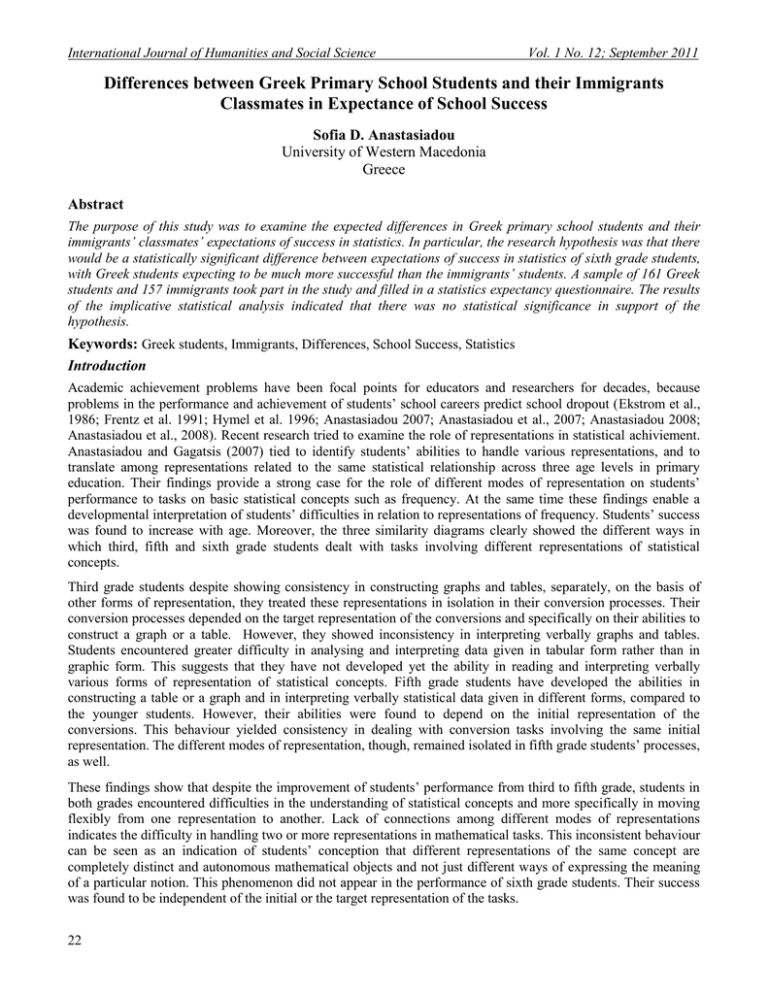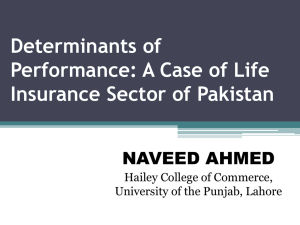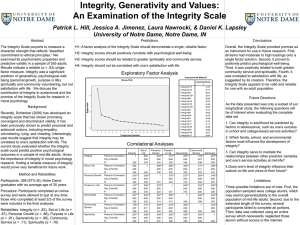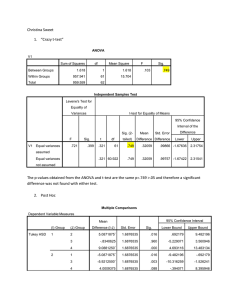Document 10466740
advertisement

International Journal of Humanities and Social Science Vol. 1 No. 12; September 2011 Differences between Greek Primary School Students and their Immigrants Classmates in Expectance of School Success Sofia D. Anastasiadou University of Western Macedonia Greece Abstract The purpose of this study was to examine the expected differences in Greek primary school students and their immigrants’ classmates’ expectations of success in statistics. In particular, the research hypothesis was that there would be a statistically significant difference between expectations of success in statistics of sixth grade students, with Greek students expecting to be much more successful than the immigrants’ students. A sample of 161 Greek students and 157 immigrants took part in the study and filled in a statistics expectancy questionnaire. The results of the implicative statistical analysis indicated that there was no statistical significance in support of the hypothesis. Keywords: Greek students, Immigrants, Differences, School Success, Statistics Introduction Academic achievement problems have been focal points for educators and researchers for decades, because problems in the performance and achievement of students’ school careers predict school dropout (Ekstrom et al., 1986; Frentz et al. 1991; Hymel et al. 1996; Anastasiadou 2007; Anastasiadou et al., 2007; Anastasiadou 2008; Anastasiadou et al., 2008). Recent research tried to examine the role of representations in statistical achiviement. Anastasiadou and Gagatsis (2007) tied to identify students’ abilities to handle various representations, and to translate among representations related to the same statistical relationship across three age levels in primary education. Their findings provide a strong case for the role of different modes of representation on students’ performance to tasks on basic statistical concepts such as frequency. At the same time these findings enable a developmental interpretation of students’ difficulties in relation to representations of frequency. Students’ success was found to increase with age. Moreover, the three similarity diagrams clearly showed the different ways in which third, fifth and sixth grade students dealt with tasks involving different representations of statistical concepts. Third grade students despite showing consistency in constructing graphs and tables, separately, on the basis of other forms of representation, they treated these representations in isolation in their conversion processes. Their conversion processes depended on the target representation of the conversions and specifically on their abilities to construct a graph or a table. However, they showed inconsistency in interpreting verbally graphs and tables. Students encountered greater difficulty in analysing and interpreting data given in tabular form rather than in graphic form. This suggests that they have not developed yet the ability in reading and interpreting verbally various forms of representation of statistical concepts. Fifth grade students have developed the abilities in constructing a table or a graph and in interpreting verbally statistical data given in different forms, compared to the younger students. However, their abilities were found to depend on the initial representation of the conversions. This behaviour yielded consistency in dealing with conversion tasks involving the same initial representation. The different modes of representation, though, remained isolated in fifth grade students’ processes, as well. These findings show that despite the improvement of students’ performance from third to fifth grade, students in both grades encountered difficulties in the understanding of statistical concepts and more specifically in moving flexibly from one representation to another. Lack of connections among different modes of representations indicates the difficulty in handling two or more representations in mathematical tasks. This inconsistent behaviour can be seen as an indication of students’ conception that different representations of the same concept are completely distinct and autonomous mathematical objects and not just different ways of expressing the meaning of a particular notion. This phenomenon did not appear in the performance of sixth grade students. Their success was found to be independent of the initial or the target representation of the tasks. 22 © Centre for Promoting Ideas, USA www.ijhssnet.com Their high and consistent outcomes in all of the conversion tasks indicate that they have developed the understanding of the relations among representations and the skills of representing and handling flexibly basic statistical knowledge in various forms. A possible explanation is that the older students could recognize the mathematical structure and content of the tasks in different representations and deal more flexibly with these components, either by translating them to another representation or by giving an interpretation for them. This suggests that development and instruction generate general cognitive strategies that are increasingly independent of representational factors. The above finings are in a line with the results of a similar study of Anastasiadou, Elia and Gagatsis (2007). The main objective of Anastasiadou (2008) study was to contribute to the understanding of the role of the four different types of representations and translations in statistical problem solving (SPS) in Greek primary school. Specifically, this study investigates the abilities of 3rd, 5th and 6th grade primary school indigenous students and immigrants in using representations of basic statistical concepts and in moving from one representation to another. The samples of the studies consisted of students of primary schools in Greece. The results of this study reveal that indigenous students have not acquired sufficient abilities for transformation from one representation system to another. Results reveal the differential effects of each form of representation on two groups’ students’ performance and the improvement of performance with age of indigenous students. Moreover, the three similarity diagrams clearly showed the different ways in which third, fifth and sixth grade students dealt with tasks involving different representations of statistical concepts. These findings show that despite the improvement of students’ performance from third to fifth grade, students in both grades encountered difficulties in the understanding of statistical concepts and more specifically in moving flexibly from one representation to another. Lack of connections among different modes of representations indicates the difficulty in handling two or more representations in mathematical tasks. This incompetence is the main feature of the phenomenon of compartmentalization in representations, which was detected in both third and fifth grade students (Duval, 2002). The phenomenon of compartmentalization in representations had also appeared with immigrants in the all three grades. The main difference of immigrants in relation to indigenous students is that there was no improvement of performance with age. This phenomenon did not appear in the performance of sixth grade indigenous students. Their success was found to be independent of the initial or the target representation of the tasks. The basic problem with immigrants is the understanding of the verbal representations as an initial and final mode and this due to the general difficulties that immigrants face with the Greek language. This study tries to find out whether still there is difference between Greek high school indigenous and immigrants in statistical achievement. Also it examines the role of others factors that influence Statistics Achievement such as Family Factors. Purpose of the study Until the 1980s Greek society was one of the most homogeneous societies racially, culturally and linguistically. From that time until now there has been a continual but fluctuating influx of “foreigners” of contrasting characteristics: economic immigrants from ex-soviet union countries after the collapse of that state, new refugee (Greeks originating from the Pontos) from ex-soviet countries, economic immigrants and political refugees from mostly eastern Islamic countries. This mainly economic immigration created a new reality of inequality of multilingual, multiculturality in a country, or rather in a nation-state remarkably homogeinic linguistically and culturally (Kogidou, Tressou & Tsiakalos, 1997). Thus the Greek primary school pupils population consists of indigenous and immigrants’ pupils. The purpose of the study is the exanimation of the relations among Greek indigenous and immigrant high school students' Statistics Achievement could be related to quality of students’ family factors, social relationships, socioeconomic factors, and ethnicity. Research sample- Teaching statistics-Research methodology The sample: Α sample of 453 Greek students and 475 immigrants of ninth grade (14-15 years of age) took part in the study and filled in a Statistics Achievement test that it was created for the purpose of the study.The Questionnaire: The questionnaire consists of 10 exercises and questions regarding the concept of probability, frequency tables, bar charts and their application to solving everyday problems marked by two grades each. Students’ marks were used as indicators for students Statistics Achievement. Teaching statistics in the ninth grade: According to the curricula, students usually learn to: *Record data, 23 International Journal of Humanities and Social Science Vol. 1 No. 12; September 2011 *Portray data through the relevant graphic representations, *Make assumptions and predictions regarding the results of the relevant actions, *Reach the relevant conclusions based on the data. Additionally, according to the aims of the curricula, third grade primary school pupils must be able to: *Perceive the concepts of chance, possibility and probability, as well as the relationship between them, *Detect probable events, *Calculate the frequency of events and categorise the relevant statistical data, *Create the relevant tables. In conclusion, one can claim that the use of statistics is restricted to a chart of statistical calculations, which includes examples that refer even to the everyday experiences of students. Research methodology: Correlations and Multivariate Statistical Analysis were used to analysed the data. Research Questions This article addresses the following research questions. 1. Statistics Achievement is related to family factors. 2. Could Statistics Achievement be influenced by students’ gender? 3. Can mothers’ expectations have a substantial effect on students’ Statistics Achievement? 4. Can the parents’ educational level have a serious influence on students’ Statistics Achievement? 5. Can parents’ occupation in relation to parents’ economic status have a serious effect on students’ Statistics Achievement? 6. Can presence of study aids have a serious effect on students’ Statistics Achievement? 7. Can living with different family members have a serious effect on students’ Statistics Achievement? 8. Is true that when students spend their extracurricular time in various activities their Statistics Achievement is minimised. 9. Can students’ ethnicity have a serious influence on students’ Statistics Achievement? Additionally, the said research project also examined the following 9 hypotheses: Η1: Statistics Achievement is not influenced by gender. Η2: Statistics Achievement is not influenced by mothers’ expectations. Η3: Statistics Achievement is not influenced by father’ level of education. Η4: Statistics Achievement is not influenced by mother’ level of education. Η5: Statistics Achievement is not influenced by father’ occupation. H6: Statistics Achievement is not influenced by mother’ occupation. H7: Statistics Achievement is not influenced by study aids by a private teacher. H8: Statistics Achievement is not influenced by living with different family members (seperated families, living with grand parents etc.). H9: Statistics Achievements not influenced by extracurricular time in various activities H10: Statistics Achievement is not influenced by students’ ethnicity. Results Correlations between students' achievement and a set of indicators are presenting in the following tables. There is no significant correlation between achievement and students’ gender (r=0.029, p=0.383>0.05) (Table 1). Thus the null hypothesis Η1 that there is no statistically difference among the gender groups in terms of Statistical achievement is accepted. Table 1: Statistics Achievement and sex Achievement SEX Pearson Correlation Sig. (2-tailed) N Pearson Correlation Sig. (2-tailed) N Achievement SEX 1 ,029 . 928 ,383 928 ,029 1 ,383 928 . 928 There is significant correlation between achievement and mothers’ expectations (r=0.578, p=0.000<0.01) (Table 2) at a 2- tailed significant level of 1%. Thus the null hypothesis Η2 that tatistics Achievement is not influenced by mothers’ expectations is rejected. 24 © Centre for Promoting Ideas, USA www.ijhssnet.com Table 2: Statistics Achievement and Mother’ Expectations Achievement Mot’ exp Pearson Correlation Sig. (2-tailed) N Pearson Correlation Sig. (2-tailed) N Achievement Mot’ exp 1 ,587(**) . 928 ,000 928 ,587(**) 1 ,000 928 . 928 ** Correlation is significant at the 0.01 level (2-tailed). There is significant correlation between achievement and Father’ Education (r=0.498, p=0.000<0.01) (Table 3) at a 2- tailed significant level of 1%. Thus the null hypothesis Η3 that Statistics Achievement is not influenced by father’ level of education is rejected. Table 3: Statistics Achievement and Father’ Education Achievement Father Ed Pearson Correlation Sig. (2-tailed) N Pearson Correlation Sig. (2-tailed) N Achievement Father Ed 1 ,498(**) . 928 ,000 928 ,498(**) 1 ,000 928 . 928 ** Correlation is significant at the 0.01 level (2-tailed). There is significant correlation between achievement and Mother’ Education (r=0.585, p=0.000<0.01) (Table 4) at a 2- tailed significant level of 1%. Thus the null hypothesis Η4 that Statistics Achievement is not influenced by mother’ level of education is rejected. Table 4: Statistics Achievement and Mother’ Education Achievement Mother Ed Pearson Correlation Sig. (2-tailed) N Pearson Correlation Sig. (2-tailed) N Achievement Mother Ed 1 ,585(**) . 928 ,000 928 ,585(**) 1 ,000 928 . 928 ** Correlation is significant at the 0.01 level (2-tailed). There is significant correlation between achievement and father’ occupation (r=0.457, p=0.000<0.01) (Table 5) at a 2- tailed significant level of 1%. Thus the null hypothesis Η5 that Statistics Achievement is not influenced by father’ occupation is rejected. Table 5: Statistics Achievement and Father’ Occupation Achievement Father’ Oc Pearson Correlation Sig. (2-tailed) N Pearson Correlation Sig. (2-tailed) N Achievement Father’ Oc 1 ,457(**) . 928 ,000 928 ,457(**) 1 ,000 928 . 928 ** Correlation is significant at the 0.01 level (2-tailed). 25 International Journal of Humanities and Social Science Vol. 1 No. 12; September 2011 There is significant correlation between achievement and father’ occupation (r=0.521, p=0.000<0.01) (Table 6) at a 2- tailed significant level of 1%. Thus the null hypothesis Η6 that Statistics Achievement is not influenced by Mother’ Occupation is rejected. Table 6: Statistics Achievement and Mother’ Occupation Achievement Mother Oc Achievement 1 . 928 ,521(**) ,000 928 Pearson Correlation Sig. (2-tailed) N Pearson Correlation Sig. (2-tailed) N Mother Oc ,521(**) ,000 928 1 . 928 ** Correlation is significant at the 0.01 level (2-tailed). There is significant correlation between achievement and the Presence of Study Aids (r=0.643, p=0.000<0.01) (Table 7) at a 2- tailed significant level of 1%. Thus the null hypothesis Η7 that Statistics Achievement is not influenced by Statistics Achievement is not influenced by study aids by a private teacher is rejected. Table 7: Statistics Achievement and Presence of Study Aids Achievement Study Aids Pearson Correlation Sig. (2-tailed) N Pearson Correlation Sig. (2-tailed) N Achievement Study Aids 1 ,643(**) . 928 ,000 928 ,643(**) 1 ,000 928 . 928 ** Correlation is significant at the 0.01 level (2-tailed). There is no significant correlation between achievement and living with different family members (r=0.089, p=0.07>0.01) (Table 8) at a 2- tailed significant level of 1%. Thus the null hypothesis Η8 that Statistics Achievement is not influenced by living with different family members is accepted. Table 8: Statistics Achievement and living with different family members Achievement Dif fam mem Pearson Correlation Sig. (2-tailed) N Pearson Correlation Sig. (2-tailed) N Achievement Dif fam mem 1 ,089(**) . 928 ,07 928 ,089(**) 1 ,07 928 . 928 ** Correlation is significant at the 0.01 level (2-tailed). There is a small but significant correlation between achievement and living with different family members (r=0.297, p=0.00<0.01) (Table 9) at a 2- tailed significant level of 1%. Thus the null hypothesis Η9 that Statistics Achievement is not influenced by extracurricular time in various activities is rejected. Table 9: Statistics Achievement and Extracurricular time spent in various activities Achievement Activities Pearson Correlation Sig. (2-tailed) N Pearson Correlation Sig. (2-tailed) N Achievement 1 . 928 ,297(**) ,000 928 ** Correlation is significant at the 0.01 level (2-tailed). 26 Activities ,297(**) ,000 928 1 . 928 © Centre for Promoting Ideas, USA www.ijhssnet.com There is a significant correlation between achievement and living with different family members (r=0.621, p=0.00<0.01) (Table 10) at a 2- tailed significant level of 1%. Thus the null hypothesis Η10 that Statistics Achievement is not influenced by Ethnicity is rejected. Table 10: Statistics Achievement and Ethnicity Achievement Pearson Correlation Sig. (2-tailed) N Pearson Correlation Sig. (2-tailed) N Ethnicity Achievement Ethnicity 1 ,621(**) . 928 ,000 928 621(**) 1 ,000 928 . 928 ** Correlation is significant at the 0.01 level (2-tailed). In addition the t-test analysis (Table 11, Table 12) show that the mean value of the achievement of indigenous students (M=11.89, SD=3.049) is significant bigger (t=16.096, df=676, two-tailed p<0.05) than the one related to immigrants (M=9.30, SD=1.599). Table 11: T Test mean values Achievement STUDENTS 1 2 N 453 475 Mean 11,89 9,30 Std. Deviation 3,049 1,599 Std. Error Mean ,143 ,073 Table 12: T Test Independent Samples Test Levene's Test f or Equality of Variances F Achievement Equal variances assumed Equal variances not assumed 152,213 Sig. ,000 t-test for Equality of Means t df Sig. (2-tailed) Mean Std. Error Diff erence Diff erence 95% Confidence Interv al of the Diff erence Lower Upper 16,315 926 ,000 2,59 ,159 2,279 2,902 16,096 675,784 ,000 2,59 ,161 2,275 2,907 Conclusions This study tied to examine whether students’ statistics achievement differentiate by demographic elements. The results of Multilevel Statistical Analysis indicate that students statistics achievement differentiate by demographic elements. In addition the results of this study reveal that immigrants have not acquired sufficient abilities in statistics. Person statististical corelation results indicated that Statistical achievement is statistically influenced by mother’ expectations, father’ and mother’ level of education and their job occupation, study aids by a private teacher, various activities and finally by students’ enthicity. Suggestion for further research Like other empirical studies, this study is not without its limitations: the study can be strengthened by increasing the sample size and including participants in other schools from different geographic areas and social and economic class. With an increased sample size, a more detailed empirical analysis among the high school students and Lyceum students can be performed. It might be interesting to explore how Statistics Achievement could be related to quality of students’ social relationships and contribute to better academic learning and career choice. 27 International Journal of Humanities and Social Science Vol. 1 No. 12; September 2011 References Anastasiadou, S.: 2007, The phenomenon of compartmentalization in students’ processing of statistical concepts. International Symposium Elementary Mathematics Teaching SEMT 06 Prague, 61–68. Anastasiadou, S. (2008). Representations and learning in statistics: a comparative study between Greek primary school students and immigrants Eleventh International Congress on Mathematical Education, Monterrey, Mexico, 2008 available on line in the http://tsg.icme11.org/document/get/195. Anastasiadou, S., Chadjipantelis Th. (2008). The role of representations in the understanding of probabilities in tertiary education. Eleventh International Congress on Mathematical Education, Monterrey, Mexico, 2008 available on line in the http://tsg.icme11.org/tsg/show/14. Anastasiadou S., Eliα Ι., Gagatsis Α.(2007). Le rôle des représentations dans l´apprentissage des concepts de statistique des étudiants de l´école primaire de Grèce. In Regis Gras, Pilar Orus, Bruno Pinaud, Pablo Gregori Eds, 4nd International Conference Implicative Statistic Analysis, Castellon, Spain, pp. 135-144. Duval, R.: 2002, The cognitive analysis of problems of comprehension in the learning of mathematics. Mediterranean Journal for Research in Mathematics Education 1(2), 1–16. Ekstrom, R.B., Goertz, M.E., Pollack, J.M. and Rock, D.A., 1986. Who drops out of high school and why? Findings from a national study. Teachers College Record 87, pp. 356–373. Frentz, C., Gresham, F.M. and Elliot, S.N., 1991. Popular, controversial, neglected, and rejected adolescents: contrasts of social competence and achievement differences. Journal of School Psychology 20, pp. 257–274. Hymel, S., Comfort, C., Schonert-Reichl, K. and McDougall, P., 1996. Academic failure and school dropout: the influence of peers. In: Juvonen, J. and Wentzel, K.R., Editors, 1996. Social Motivation: Understanding Children’s School Adjustment, Cambridge University Press, New York, pp. 313–345. 28






